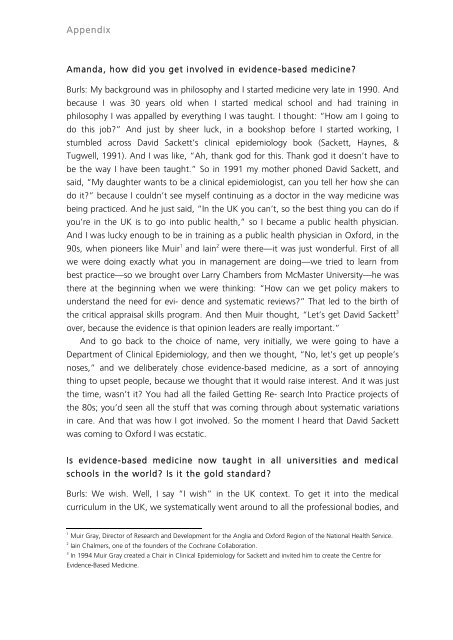In Search of Evidence
jqluvth
jqluvth
You also want an ePaper? Increase the reach of your titles
YUMPU automatically turns print PDFs into web optimized ePapers that Google loves.
Appendix<br />
Amanda, how did you get involved in evidence-based medicine?<br />
Burls: My background was in philosophy and I started medicine very late in 1990. And<br />
because I was 30 years old when I started medical school and had training in<br />
philosophy I was appalled by everything I was taught. I thought: “How am I going to<br />
do this job?” And just by sheer luck, in a bookshop before I started working, I<br />
stumbled across David Sackett’s clinical epidemiology book (Sackett, Haynes, &<br />
Tugwell, 1991). And I was like, “Ah, thank god for this. Thank god it doesn’t have to<br />
be the way I have been taught.” So in 1991 my mother phoned David Sackett, and<br />
said, “My daughter wants to be a clinical epidemiologist, can you tell her how she can<br />
do it?” because I couldn’t see myself continuing as a doctor in the way medicine was<br />
being practiced. And he just said, “<strong>In</strong> the UK you can’t, so the best thing you can do if<br />
you’re in the UK is to go into public health,” so I became a public health physician.<br />
And I was lucky enough to be in training as a public health physician in Oxford, in the<br />
90s, when pioneers like Muir 1 and Iain 2 were there–it was just wonderful. First <strong>of</strong> all<br />
we were doing exactly what you in management are doing–we tried to learn from<br />
best practice–so we brought over Larry Chambers from McMaster University–he was<br />
there at the beginning when we were thinking: “How can we get policy makers to<br />
understand the need for evi- dence and systematic reviews?” That led to the birth <strong>of</strong><br />
the critical appraisal skills program. And then Muir thought, “Let’s get David Sackett 3<br />
over, because the evidence is that opinion leaders are really important.”<br />
And to go back to the choice <strong>of</strong> name, very initially, we were going to have a<br />
Department <strong>of</strong> Clinical Epidemiology, and then we thought, “No, let’s get up people’s<br />
noses,” and we deliberately chose evidence-based medicine, as a sort <strong>of</strong> annoying<br />
thing to upset people, because we thought that it would raise interest. And it was just<br />
the time, wasn’t it? You had all the failed Getting Re- search <strong>In</strong>to Practice projects <strong>of</strong><br />
the 80s; you’d seen all the stuff that was coming through about systematic variations<br />
in care. And that was how I got involved. So the moment I heard that David Sackett<br />
was coming to Oxford I was ecstatic.<br />
Is evidence-based medicine now taught in all universities and medical<br />
schools in the world? Is it the gold standard?<br />
Burls: We wish. Well, I say “I wish” in the UK context. To get it into the medical<br />
curriculum in the UK, we systematically went around to all the pr<strong>of</strong>essional bodies, and<br />
1<br />
Muir Gray, Director <strong>of</strong> Research and Development for the Anglia and Oxford Region <strong>of</strong> the National Health Service.<br />
2<br />
Iain Chalmers, one <strong>of</strong> the founders <strong>of</strong> the Cochrane Collaboration.<br />
3<br />
<strong>In</strong> 1994 Muir Gray created a Chair in Clinical Epidemiology for Sackett and invited him to create the Centre for<br />
<strong>Evidence</strong>-Based Medicine.


